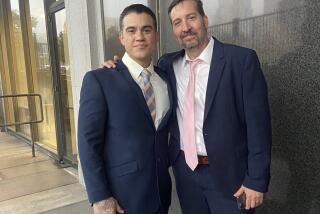Immunity : ‘It was a choice between everybody going free and seeing just one go free.’
- Share via
Police were able to break open the Takashi Sakai murder case because one of the men who took part in the killing made one major mistake: he left a fingerprint on a parking lot ticket when he left the dead man’s car at Los Angeles International Airport.
But the man who left the fingerprint, 21-year-old Greg Meier, will not face a day in jail for his part in the murder, though he admittedly helped ambush Sakai, club him with a steel pipe and bury his body after he had been stabbed to death.
Using the fingerprint as the key piece of evidence gathered in a 10-month investigation of Sakai’s disappearance, authorities in February persuaded Meier to tell what happened to the missing man and lead them to his body.
In exchange for that help and for agreeing to testify about the murder, Meier was granted immunity from prosecution. He is now expected to be the key witness in the prosecution of his best friend, Toru Sakai, 21, of Tarzana, who is charged with murder and conspiracy in the fatal stabbing of his father.
Meier is also expected to play an important role as a witness in the prosecution of Sanae Sakai, who is charged with being an accessory to her husband’s murder.
Difficult Decisions
The granting of immunity to Meier points out the frustrations and difficult decisions authorities faced in solving what they called an almost-perfect crime. Deputy Dist. Atty. Lonnie A. Felker, who will prosecute the Sakais, isn’t happy that Meier will not face prosecution, but said there was little choice.
Felker said evidence gathered against Meier may not have been enough to convict him of a part in the murder, yet the evidence he provided after receiving immunity was critical in bringing charges against the actual killer, Toru Sakai.
“Unfortunately, we had to let someone go without any jail time,” Felker said. “There was nothing else we could do. It was a choice between everybody going free and seeing just one go free. We didn’t want the person who actually inflicted the fatal blows to Takashi Sakai to walk away. Toru was the one we wanted.”
However, the prosecution of Toru Sakai will have to wait until he is found by police. His whereabouts have been unknown since he fled from his family home in Tarzana while Meier was cooperating with authorities. Meanwhile, his mother has pleaded innocent in Los Angeles Superior Court.
A look at the Sakai case shows how authorities found themselves in the uncomfortable situation of having to choose for whom justice would be served.
“Our only concern is that at the end of this thing that justice is done for as many people as possible,” Felker said. “On a professional level, I do not feel badly about it because I am doing what needs to be done to make sure justice is done.
“On a personal level, I feel badly that everyone that is involved cannot be prosecuted. It is a terrible thing to see some person who is involved just walk away.”
Criminal justice experts said the Sakai case presented a dilemma often faced by prosecutors and police. They said the granting of immunity, even in murder cases, is not uncommon.
“It is an essential element of the criminal justice system but it is troubling,” said Prof. Ernest Kamm, chairman of the Department of Criminal Justice at Cal State L.A. “It is repugnant to have to trade with someone you feel is guilty. If there is a rule of thumb, it is you try to let the least-involved person walk and you deal for the principal perpetrator.”
“Nothing is perfect,” added Robert Morneau, a former FBI agent who is also a professor at the university. “It often is the only way to make a case. But when a guy gets off scot-free, it seems exaggerated. When the system has to excuse some guy . . . it is really a travesty.”
Takashi (Glenn) Sakai, 54, a wealthy international businessman, disappeared April 20, 1987, and from the outset police believed he was the victim of foul play. Investigators learned the Sakais were in the midst of a divorce and there were bitter feelings between the missing man and his 51-year-old wife and son.
Two days after the disappearance, Sakai’s Mercedes-Benz was found parked at LAX. Police found no signs that he had taken a flight from the airport and only one clue to what happened to him--a fingerprint on the airport parking ticket stub that had been left in the car.
During the next several months the investigation moved slowly. Sakai’s body had not been found and police found no match for the fingerprint.
But in November, the operator of a private mailbox company in Hollywood where Takashi Sakai had kept a box told police that a young man had come in, presented the key and requested access to it. The man left when he was turned down because he was not Sakai, but the business operator wrote down the license number of the car he was driving.
Detectives Jerry LeFrois and Jay Rush traced the tag number to Greg Meier of San Marino.
According to authorities, Meier and Toru Sakai were close friends who had met at San Marino High School when they played on a tennis team together. Both were known as quiet kids who did not participate in many school activities. Tennis and their shared interest in becoming musicians made the basis of their friendship.
Beneath his senior photo in the 1983 Titanian yearbook, Toru Sakai skipped the inspirational messages most students chose and placed a bleakly pessimistic quote attributed to Mick Jagger:
“There’ve been good times; there’ve been bad times; I’ve had my share of hard times, too, but I lost my faith in the world. . . .”
Beneath Meier’s photo, the caption he chose read: “If you don’t get life, life will get you.”
The friendship of Meier and Sakai lasted well after high school and the Sakai family’s move from San Marino to Tarzana. The two briefly attended UCLA together and later worked occasionally doing renovation and maintenance work on homes Sanae Sakai managed for Japanese investors.
After the license plate number was traced to Meier, investigators asked him to come to police headquarters to answer questions and be fingerprinted. Meier complied and was released. There was not enough evidence to charge him with a crime.
Fingerprint Match
But by early February police had matched one of Meier’s fingerprints to the print on the parking ticket stub. Felker said on Feb. 9 investigators took Meier into custody, this time telling him the fingerprint and other evidence added up to probable cause to charge him in the Sakai case.
“We confronted him,” Felker said. “He indicated he might be able to help us.”
Meier consulted an attorney and then offered to tell what happened in exchange for immunity. Felker said that with no body, no crime scene, no motive for Meier to kill Sakai, and little other evidence beyond the fingerprint, authorities had no choice. After careful consideration by prosecutors and police, the district attorney’s office agreed.
“We concurred--it was the only way to go,” said Lt. Ron Lewis, who supervised the Los Angeles police investigation of the case. “I can’t imagine that any law enforcement officer would be too happy about an individual being allowed to walk away, but you have to take in the the total picture. Certainly it bothers me, but it was our only option.”
Before granting Meier immunity, Felker said, “we assured ourselves that he was not the actual killer and we assured ourselves that he did not initiate the thought of the killing. We gave him immunity because he was not the person who inflicted the fatal injuries.”
The next day, Meier led a team of investigators to a spot in Malibu Canyon where he pointed out the place Takashi Sakai had been buried 10 months earlier. He also provided details of the murder that had frustrated investigators for just as long.
Preliminary Hearing
Those details were revealed publicly for the first time last week when Meier, dressed in blue jeans and a dress shirt, testified at Sanae Sakai’s preliminary hearing.
Speaking calmly but often exhaling nervously into the microphone, Meier said Toru Sakai talked on and off of wanting to kill his father for three months in early 1987 before persuading a reluctant Meier to take part. He said the talks often occurred while the two friends cruised in Toru’s Porsche over the Santa Monica Mountains or dined and drank in Westwood restaurants near UCLA.
On April 20, 1987, according to Meier and authorities, Toru lured his father to a vacant home in Beverly Hills that Sanae Sakai managed for an investor.
Meier said he was standing behind the front door and hit the older man with a steel pipe when he walked in. There was an unexpected and bloody struggle and Takashi Sakai was struck several more times by Meier and his son before being subdued, handcuffed and pushed down the basement stairs. Meier testified that Toru then asked him to kill his father.
“He went over to a bag and pulled out a big knife,” Meier said. “He asked me to go down and finish him off.”
Meier said he refused, so Toru went down and killed his father. They then wrapped the body in a bloodstained rug, he testified, and loaded it into Toru’s Porsche. He said they drove to Malibu Canyon and buried the body before returning to the Beverly Hills house the next day to paint over the blood-spattered walls.
Meier, according to Felker, said that when he drove the dead man’s car to LAX the day after the murder, he wore gloves so there would be no fingerprints left in the car. But when he had to reach out the window to take the parking stub, he took the gloves off so he would not look suspicious. After he got the stub, he put the gloves back on and rubbed the stub between his hands to erase any fingerprints.
“But the oil from one of his fingers had already been absorbed into the paper,” Felker said. “The print stayed there. It was the one thing” that connected him with Takashi Sakai’s disappearance.
Several months later, when Meier confessed his role in the murder to authorities, he added one other grim detail to an already a gruesome case, Felker said.
He said Meier told investigators that about two months after the murder he and Toru returned to the grave site and partially dug up Takashi Sakai. Toru Sakai used a pair of shears to cut a finger off the body so he could remove a ring. The body was reburied. Felker did not disclose whether the ring was taken to hide evidence or because Toru wanted it.
A year later, Meier faces no criminal charges in the Sakai case, but does face his own guilt, Felker said.
“I don’t really know how to judge how much he feels remorse,” Felker said. “I know he feels badly about it. He has told me about it several times. The murder wasn’t reality to him until it happened. He was so deeply involved then that he had to stay involved.”
Meier could not be contacted for comment. But during his testimony last week, he momentarily faltered while being questioned about the murder.
“This is tough,” he said. “It’s tough, emotionally.”
More to Read
Sign up for Essential California
The most important California stories and recommendations in your inbox every morning.
You may occasionally receive promotional content from the Los Angeles Times.









